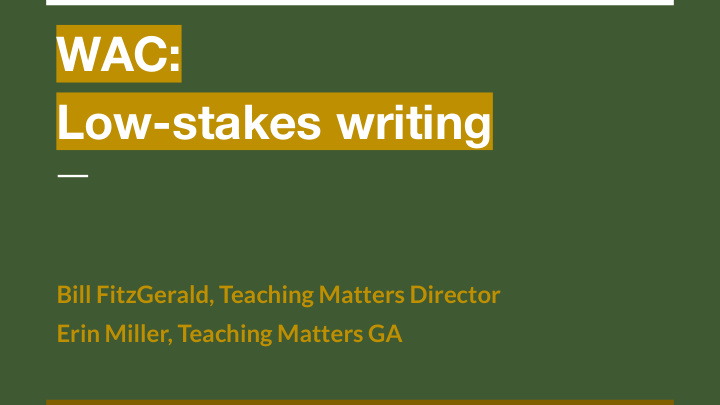



WAC: Low-stakes writing Bill FitzGerald, Teaching Matters Director Erin Miller, Teaching Matters GA
Overview Defining Evaluating Implementing 1 2 3 low-stakes writing low-stakes writing low-stakes writing Understanding Rubrics Situating LSW in your ● ● ● low-stakes writing class Responses ● Explaining LSW to your Examples of LSW ● ● Is evaluation necessary? ● students assignments Teacher-determined vs. ● student-determined writing
Part 1 What is low-stakes writing? University of Waterloo’s Centre for Teaching Excellence frames LWS as follows:
Part 1 How can we explain LSW to our students? Determine the purpose of the LSW assignment ● Emphasize process over product, learning over demonstrated learning (Elbow). ○ Explain how it will fit into the course material and learning goals ○ Set time or page limits ● Explain evaluation processes ● Check system with accompanying rubric ○ Short responses ○ No response at all ○
Part 1 Who determines the goals of LSW? The teacher Teacher-determined writing seeks a specific result in LSW, such as students drawing a ● connection between two concepts or the definition of a key term in the student’s own words. Teacher-determined writing often connects to a specific learning goal (Bean 108). The student Student-determined writing allows the student to determine their goals for writing. The ● student has “more freedom to ask their own questions, pursue their own issues, do their own pondering” (Bean 108).
Part 2 How to evaluate low-stakes writing Check system with rubric Short feedback No response needed (*must define expectations) Suggested format: Depending on the assignment and Provide one sentence of ● who determines the goal of the + means the assignment was ● feedback about the student’s assignment, you may not need to completed and exceeds LSW with emphasis on the respond at all. expectations ideas presented. Alternatively, you may have students means the assignment was Provide one follow-up ● ● read one another’s work as an completed and meets most or question to promote informal measure of checking for all expectations additional writing. completion or comprehension. Try to incorporate peer checking into paired - means the assignment was ● or small group work/discussion. completed and did not meet expectations
Part 3 Situating low-stakes writing Integrating into current course structure Where can you fit in LSW into your course structure? What materials are especially ● challenging or thought-provoking that you want students to spend more time with? Plan on using multiple LSW assignments in your course consistently. ● Scaffolding assignments What high-stakes writing assignments (such as essays or reports) can you improve by ● adding LSW assignments to the invention and drafting stages? In-class writing or online writing Consider where you want LSW to take place—in (virtual) class, in a private notebook, on ● discussion boards, padlet, hypothesis, etc. Each platform offers its own benefits for LSW.
Part 3 Low-stakes writing ideas Example 1: check-in during class — check-in with students by having them summarize the class so far and write questions they have about the material Example 2: double entry journals — students take formal/normal notes and then write a commentary on their notes, adding questions, ideas, connections, etc Example 3: writing dialogues — students put opposing views encountered in course materials or independent research into conversation with one another by writing a dialogue between those sources Example 4: extended analogies — students explain a concept from class in terms of something they already know (ie. making the comparison “writing an essay is like training for a marathon” and expanding on it)
Part 3 Low-stakes writing ideas Example 5: focused freewriting — provide students with multiple prompts from which to approach the same topic Example 6: thesis-statement writing — students summarize an essay’s main argument in one sentence (this LSW is not exploratory, but still helpful) Example 7: defining key terms/concepts — students define key terms or concepts learned in class Example 8: directed paraphrasing — students write about a topic or concept from class in their own voice
Part 3 Low-stakes writing ideas Example 9: “explain it like I’m five” * — students explain a concept from class as if they were talking to a child. This LSW allows students to assume expertise on the concept.* Example 10: what you already knew/what you know now *— before covering a new topic, have students write what they already know about it, after they’ve learned the topic, have them reflect on what they now know about the topic. *These LSW ideas were contributed by Emily Helck, a writing instructor at Rutgers-Camden.
Works cited Low-Stakes Writing Assignments, University of Waterloo Centre of Teaching Excellence Low-Stakes Writing, Michelle LaFrance, George Mason University "Informal, Exploratory Writing Activities," John Bean, Engaging Ideas
Recommend
More recommend